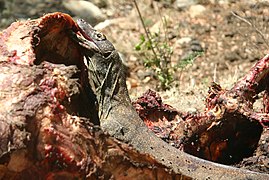Komodo National Park
Scuba diving is popular because of the park's high marine biodiversity. The development of, largely marine-based, ecotourism is the main strategy to make the park self-financing and generate sufficient revenue through entrance fees and tourism licenses to cover operational and managerial costs. To this end, a joint venture between TNC and a tourism operator were granted a tourism concession, that also entails extensive park management rights. This concession has generated an ongoing controversy. The joint venture has been accused of making decisions behind closed doors, and many people in and around Komodo claim that they haven’t been consulted regarding decisions that ultimately affect their lives.
The hot and dry climate of the park, characterized by savannah vegetation, makes it a good habitat for the endemic Komodo dragon (Varanus komodoensis). Their populations are restricted to the islands of Komodo (1,700), Rinca (1,300), Gili Motang (100), Gili Dasami (100), and Flores (c. 2,000), while extinct on Padar.
- Komodo dragon feeding on a carcass
- Water buffalo
- Crab-eating macaque
- Komodo dragon stalking deer. Note the tracking device on the dragon's neck
- Komodo on Rinca
Your notes (private)
What's on your mind? (you can type here notes just for you and they will show on your dashboard)
Information for getting there
When someday comes you'll need to get in.
Information for getting around
When someday comes you'll need to be able to get around.
Your tips and questions
Let us know your best tips about Komodo National Park.





